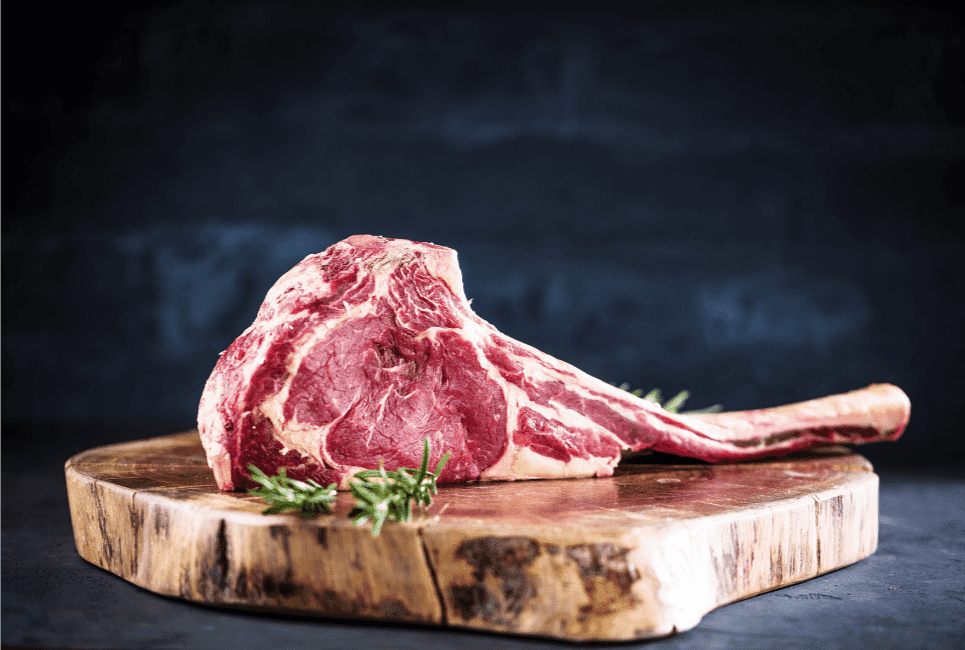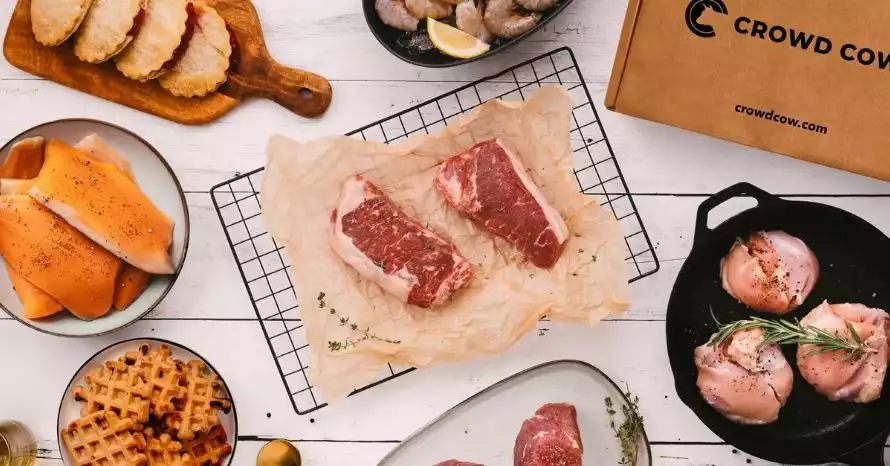- Palomilla Steak Guide: 6 Things You Need to Know About the Palomilla Steak - June 10, 2022
- Cotto Salami Guide and History - April 4, 2022
- Tomahawk Steak vs Ribeye: What is the Best Option? - March 31, 2022
Every food lover out there has tried steaks at one point in their life or is thinking about it. I hardly blame them – there’s something to be said for a juicy meal with a side of artfully made sauces and vegetables. Mashed potatoes, pineapple sauce, sauteed vegetables, and some steak on the side? Yes, please.
So, of course, when I decided I was going to try my hand at it, I found out it wasn’t as simple as going to the supermarket and picking up meat labeled “steak.” I went to my default source of knowledge for all things culinary – my grandma.
But she’s an old South Asian woman, and though I’ll never be able to make parathas as delicious as the ones she makes, she wasn’t much help in what cut of steak I should buy – or what steak even was, since it’s not really part of the traditional food I learned to cook from her.
Get grass-fed steaks, pasture-raised craft beef, pastured chicken, heritage pork and more meat you can't find anywhere else ― delivered right to your door.
Hence began my research into meat cuts and steak, and I realized how many different ways there were to cut up a single piece of meat. Now, allow me to share my knowledge with all of you.
What is Steak?
Steak is meat taken from the hindquarters of an animal, usually cut into thick slices of varying degrees depending on what kind of steak it is. The most common ways to cook steak are to dry or grill it, but it can also be minced and used in beef patties.
Main Differences Between Tomahawk vs Ribeye Steak
Before we go into the basics of steak and then talk in-depth about what both Tomahawk and Ribeye steaks are like, let’s take a look at the differences between the two.
- The Tomahawk steak has a 5-8 inch bone jutting out of the steak. This makes the steak look like a Native American Tomahawk axe, giving the steak its name, whereas, Ribeye steak is made from the same meat, but it does not have that bone jutting out of it.
- While ribeye and tomahawk steaks both come from the same part of the animal, Ribeye steaks are cheaper. This is because Tomahawk steaks are left with the bone in, and the bone is cleaned with a process called Frenching. The skill required for that process is what drives the prices up, whereas Ribeye steaks do not require special attention after cutting.
- You’ll never find a Tomahawk steak without that long bone jutting out of it, whereas Ribeye steak doesn’t always have a bone in it – there is both a bone-in and bone-free variety.
- The Tomahawk steak is a bit tricky to cook at home, mainly because of the bone. If your kitchen isn’t well-equipped or if you don’t have a grill, you might have trouble cooking it, whereas the ribeye steak is easier to cook.
- Tomahawk steak takes longer to cook than boneless Ribeye (the more common type of ribeye steak) because of the bone inside. It also provides some extra tenderness, whereas the Tomahawk steak can be harder to maneuver with the bone in.
Ribeye Steak
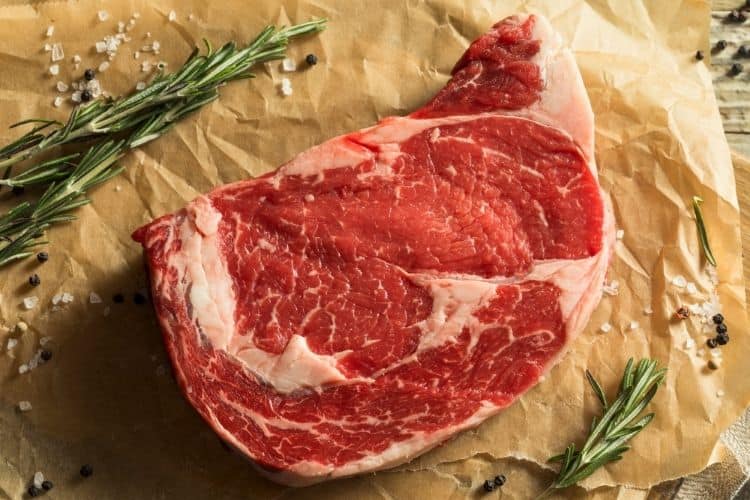
Where Does it Come From
Ribeye steak comes from the meat running along an animal’s spine. It has a lot of marbling, the meat is juicy and tender, and it’s full of flavor too. This is mainly all because of where it comes from, and it isn’t the only cut of steak that comes from this portion in the animal.
There are cuts of steak like Tomahawk that are all from this portion, mainly because people realize how delicious the meat is.
What is it Like
Ribeye steak is one of the most popular steak cuts out there. It has a lot of marbling which gives it a rich and buttery taste. You can probably get away with under-seasoning this one, and it’s a good cut to cook if you’re scared of overcooking the meat – it won’t go dry as easily as some other steak cuts because of all the marbling.
There are actually two different versions of the ribeye steak, one with the bone in and the other without the bone. Cooking the bone in version is a bit trickier than cooking it without the bone, and you might need some maneuvering with the fork and knife if you’re eating ribeye steak with the bone inside.
How to Cook Ribeye Steak
Like I just mentioned, you can get away with under-seasoning Ribeye, and some chefs might even just smear it with salt before they cook it on a pan. You need to cook it on high heat until it’s medium brown, and a meat thermometer is recommended to make sure you get exactly the right level of cooking on this steak.
You can then serve it with various side dishes of your choosing.
Tomahawk Steak
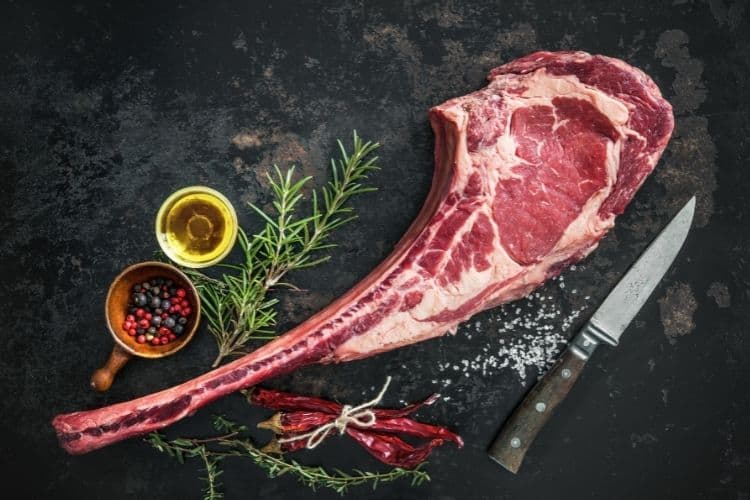
Where Does it Come From
The tomahawk steak is considered to be like a ribeye steak with the bone in, and it comes from the muscles that run along the animal’s spine. This part of the muscle is rarely ever used by the animal, and it makes the meat really tender and succulent.
The steak is cut using a special technique called frenching that leaves the bone intact inside it while at the same time making sure it’s clean and seems like a handle.
What is it Like
Like I just said, Tomahawk steak is really tender and high-quality meat, with a bone jutting out of it that’s at least five inches in length. This makes the whole thing resemble a Native American axe called the tomahawk, which is how the steak gets its name.
Tomahawk steak has a really distinct appearance, and the visual effect can be striking, to say the least.
How to Cook Tomahawk Steak
Since tomahawk steak, too, is more or less taken from the same part of the animal as the ribeye steak, they’re cooked pretty much the same way too. I do suspect that leaving the bone inside the tomahawk steak lends it some extra flavor and juiciness, but the cooking process is the same.
Cook it on high flame until it’s medium-rare, and try to keep the seasoning to a minimum if you want to enjoy the meat’s own flavor.
Other Types of Steak
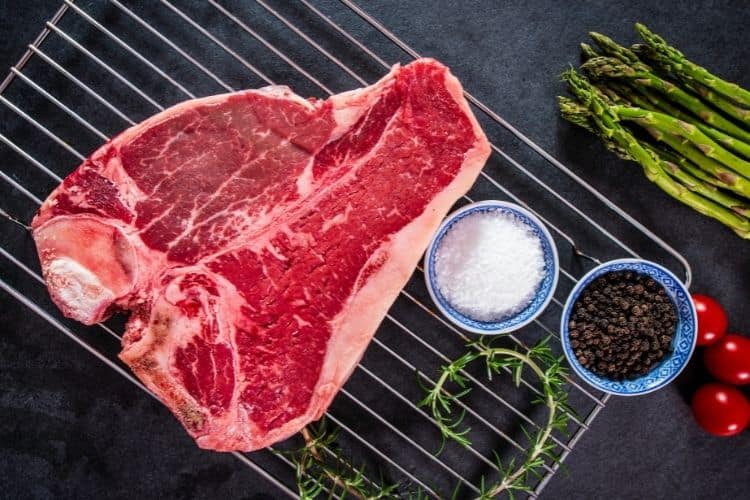
Steak is pretty popular all over the world, and it’s because of this popularity that there are countless cuts and types of steaks out there. As it grows in popularity, or even if its popularity stays the same, I think more and more ways to cook and eat meat from these parts of the animal are going to be invented.
Currently, there are over a dozen types of steak that I can think of, ranging from the relevantly tougher but hearty and flavorful rump to the tender and melt-in-your-mouth ribeye steak.
I’m going to keep this section short since this article is about two specific kinds of steaks, but I think you guys should know about all the other kinds of steaks there are, and the basics of where they come from, and how they’re used.
Porterhouse Steak
This steak is both ribeye and strip steak that’s sold on the bone, and the T-bone steak is just a smaller version of this steak. Since it contains two different types of meat, it’s tricky to cook, but if you cook it while keeping the strip section closer to the heat source since it takes more heat to cook. You can use a meat thermometer to make sure the meat is cooked properly, but make sure not to cook it higher than medium-rare.
Hanger Steak
This is steak from the belly portion of the animal and one of the more tender steaks out there. What’s better is that it’s severely underrated – hence cheaper than some of the other cuts in the market. This steak marinades well and is often used in Mexican cuisine as well as some other traditional dishes around the world. If you want to eat it, marinate it in vinegar or citrus juices and spices before cooking it on high heat.
Tenderloin Steak
This steak is known for its buttery tenderness more than its flavor, but you already know this if you’ve tried filet mignon – they’re similar cuts, and a lot of people consider them to be more or less the same. All you need to do is sear them on all slides in some spices, and they’re good to go. This is because these steaks don’t have a lot of marbling to give them flavor or moisture.
Rump
These steaks are tricky to cook and might need some tenderizing and marinating before they’re ready, but once you marinate them for four to five hours and cook them right, they’ll be one of the more flavorful steaks out there.
How to Buy Steak
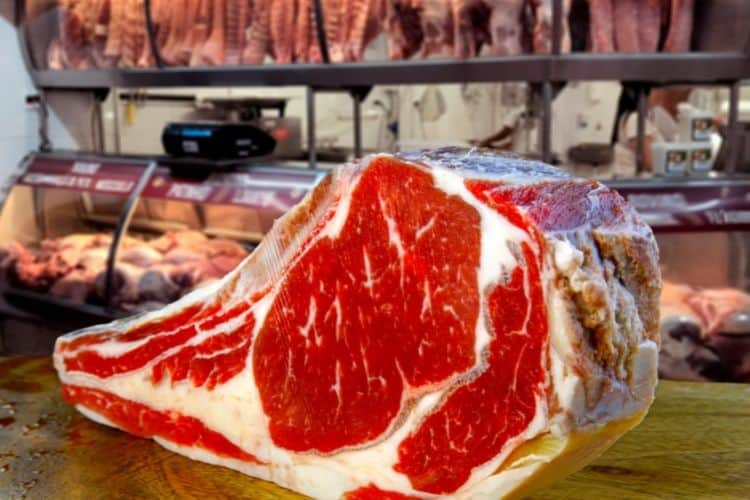
Knowing good quality steak from bad quality ones is just as important as knowing how to cook the different types to perfection. You don’t want to go to the grocery store and accidentally end up buying steak that is just days from spoiling or that won’t cooperate when you try to cook it.
Good thing is, there are ways to tell whether a steak is good or not before you find out the hard way.
Stick to these guidelines and treat each of these headings like a mental checklist you need to go through while checking meat before you buy it. Pretty soon, you’ll be able to tell if meat is fresh and good quality or not just with one look!
Check the Packaging
Good quality steak is hardly going to come in packaging that reminds you of a faulty printer. Check the packaging of any steak you buy to make sure it’s properly sealed, that the packaging quality is good and that the print on it is legible.
Don’t buy the steak if you feel like any of these things aren’t as good as they should be or that the packaging is flimsy or even torn in certain places.
What is the Color
Fresh steak is going to be bright red in color, and steak that’s a day or two old might be reddish-brown. This is a sign of oxidation, and it may be okay to buy this steak if you plan on cooking it on the same day.
If the steak is any other color, like grey, green, or has patches, it’s a sign that the steak isn’t really great – in fact, these are all signs of the steak beginning to go bad.
How Much Connective Tissue Does it Have
The connective tissue on top of a steak needs to be cut smoothly. If it seems like it’s been cut by unprofessional hands or that it’s been cut with a blunt knife, steer clear of it. A good quality steak is going to be cut with care and by a practiced hand and doesn’t feel rough at the surface.
How Fresh is it
Freshly cut beef is a bright red color, and this is the meat you should prefer over other kinds. In a day or two, the beef can turn slightly reddish-brown, which is alright. It just means that oxidation has occurred and is not a sign of spoilage. This meat is completely safe to buy if you intend to cook it the same day or the next, but if you’re buying steak for the weekend barbeque on a Wednesday, this steak isn’t a great option.
Any other color of steak is bad news. Colors like dark brown, grey, green, or with any type of patches on the surface need to be avoided. These colors are all signs of major spoilage and shouldn’t even be on the shelves, to be honest.
What Does the Marbling Look Like
Marbling on a steak refers to the white streaks of fat that run through the muscles in a steak, and they’re supposed to add extra flavor and tenderness to the steak.
Marbling on good quality, clean, and fresh steak is supposed to be white or cream-colored, but it can also be pale yellow if the animals are fed an all-grass diet. If you notice a yellowish tinge in the marbling, ask your butcher or supermarket about the diet of the animals they’re selling, and if you can’t know their diet for sure, I’d suggest avoiding buying this meat.
You also need to watch out for any spotting or patches of discoloration on the marbling and any signs that make the meat look less than ideal.
What Does it Smell Like
Smelling meat is one of the best ways to find out if it’s good or not, and while no one likes the smell of raw meat, it’s nothing like the rancid smell of a steak going bad. Take a whiff of the meat if you can, at the risk of looking like a weirdo in the store.
Rotting meat will smell very different, and you’ll most probably be able to tell immediately if something’s wrong with the meat.
What is the Texture Like
Rotting meat has a tendency to develop a slimy, slippery texture that’s in no way appetizing. Not all butchers and meat sellers are going to let you touch the meat and check if it’s slimy but do so as soon as you can so you can return it if you detect something amiss.
How to Store Steak
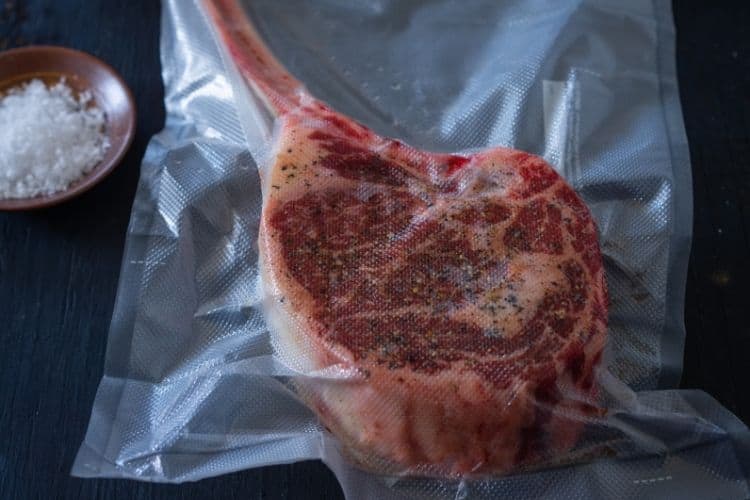
Steak can last in the freezer up to five days, after which it needs to be cooked, or it’ll start going bad. Even then, you risk the meat going to waste if you don’t store it properly, which is why I always recommend storing the steak in a vacuum-sealed Ziploc bag and then freezing it.
This makes it extremely hard for any mold or bacteria to come in contact with the steak at all, which is pretty much the whole idea.
Left to its own devices, the steak will spoil pretty easily. Don’t forget, bacteria might be hindered because you put something in the fridge or freezer, but fungi and molds are not so easily deterred. If you let the steak sit in the freezer for too long, it will eventually fall victim to its own enzymes, juices, and bacteria.
FAQs About Steaks
Answer: Tomahawk and ribeye steaks come from the middle portion of the cow’s back. The steak is actually meat that’s running along the spine there and is an extremely tender, juicy, and exquisitely marbled cut of meat.
Answer: There are at least a dozen different cuts of steak out there, all taken from different parts of the animal or the same parts cut in various ways. The Tomahawk steak and the Ribeye steak, for example, both come from the same part of the animal but are very different, character-wise.
Answer: If you’re choosing between tomahawk and Ribeye steak, I would suggest cooking ribeye steak at home, or you could start with something simpler like rump and then work your way up to ribeye and tomahawk steaks.
Answer: Making steak at home is all about precision. Overcook steak a little, and it might lose all of its flavor, and no one wants undercooked steak either. The trick is to practice making steaks often and to use a thermometer to precisely check the temperature of your steaks while they cook. Once they reach the right temperature, take them off the pan immediately.
You might eventually develop a sense for what’s the right temperature and what isn’t, but it’s always better to be precise and follow cooking instructions when cooking steak. If you want to be creative during the process, save it for when you’re preparing the sides.
Answer: When it comes to wine, I would suggest going with something fruity and sweet. This is to counter the charred and meaty textures of the ribeye steak that’s usually cooked by searing it on high heat in a pan. That said, you can never go wrong with a classic pairing of mashed potatoes, a good sauce, and some vegetables with your steak.
I also enjoy citrusy, fruity, and sweet flavors to complement the richness and the meatiness of the steak, mainly by incorporating things like oranges or pineapples either in the sauce, the cooking process itself, the garnishing, or the marination of the steaks and other meat dishes I make.
Conclusion
Tomahawk steak is a great option for when you’re dining out on a special occasion, but you can get the same thing in a bone-in Ribeye steak if you want to cook it at home.
The absence of a long bone jutting out of the Ribeye steak also helps you cook it better and is a great option for anyone who has a small kitchen or one that isn’t very well equipped. Hey – we all want a nice meal from time to time!
Get grass-fed steaks, pasture-raised craft beef, pastured chicken, heritage pork and more meat you can't find anywhere else ― delivered right to your door.
Looking for more interesting readings? Check out:

